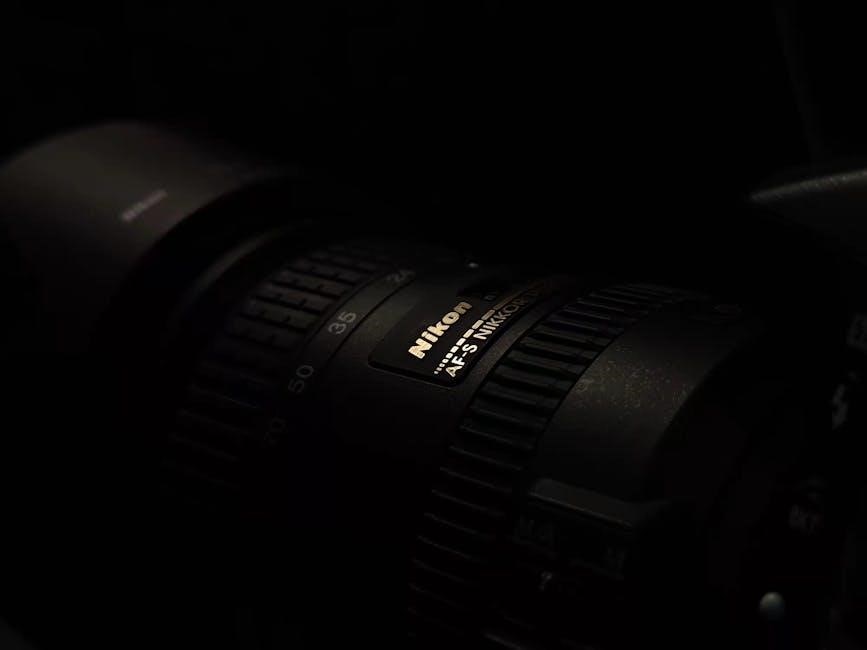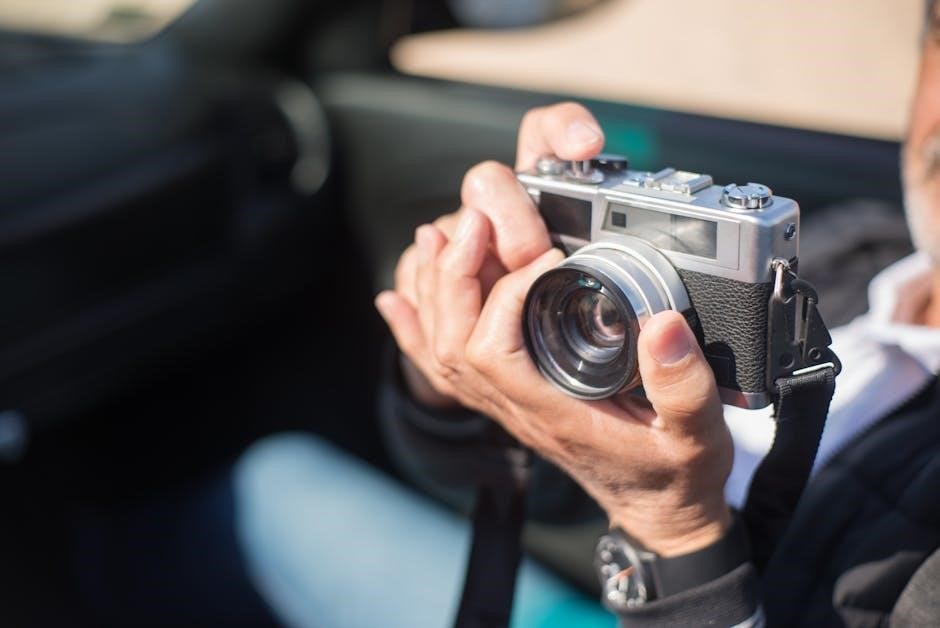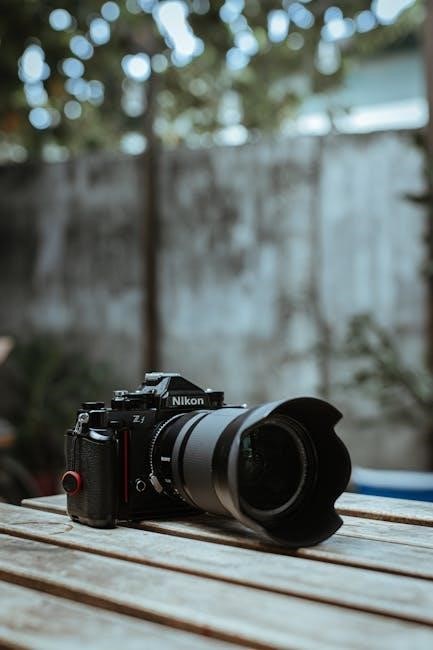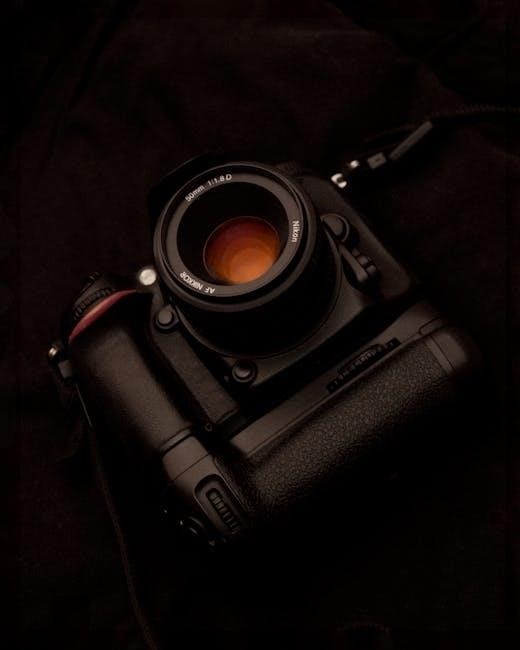The Nikon D810 is a high-performance DSLR camera designed for professional photographers and enthusiasts. It features a 36;3MP FX-format sensor, 51-point autofocus system, and advanced shooting modes.
1.1 Overview of the Nikon D810
The Nikon D810 is a professional-grade DSLR camera equipped with a 36.3MP FX-format CMOS sensor and EXPEED 4 image processor. It delivers exceptional image quality, with ISO sensitivity up to 51200 and 51-point autofocus. The camera supports full HD video recording and features a weather-sealed design for durability. Its robust build and advanced features make it ideal for photographers seeking high performance in various shooting conditions. This overview provides a foundation for understanding the camera’s capabilities before diving into its detailed operation.
1.2 Importance of the Owner’s Manual
The Nikon D810 owner’s manual is an essential resource for mastering the camera’s features and settings. It provides detailed explanations of advanced functions, custom settings, and troubleshooting tips. Whether you’re a professional or an enthusiast, the manual helps you unlock the camera’s full potential. It also serves as a reference guide for understanding the menu system, shooting modes, and video recording capabilities. By familiarizing yourself with the manual, you can optimize your photography experience and make the most of your Nikon D810.

Accessing the Nikon D810 Manual
The Nikon D810 manual is available online as a free PDF download from Nikon’s official website or via the Nikon Manual Viewer 2 app for mobile devices.
2.1 Where to Find the Nikon D810 Manual
The Nikon D810 manual can be easily accessed through various channels. Visit Nikon’s official website and navigate to the support or product manuals section. Additionally, the manual is available for download on trusted photography forums and review websites. The Nikon Manual Viewer 2 app offers another convenient option, allowing users to access the manual directly on their smartphones or tablets. Ensure to download from reputable sources to avoid unauthorized content.
2.2 Downloading the Manual in PDF Format
The Nikon D810 manual is readily available for download in PDF format, ensuring easy access to detailed instructions. Visit Nikon’s official website, navigate to the support section, and select the D810 model. From there, you can download the complete user manual. The PDF format allows for convenient viewing on computers, tablets, or smartphones. Ensure you have a PDF viewer installed to access the file. This format preserves the manual’s layout, making it easy to navigate and reference key features and settings anytime, anywhere.
2.3 Using the Nikon Manual Viewer 2 App
The Nikon Manual Viewer 2 app offers a convenient way to access the D810 manual on mobile devices. Download the app for free from the App Store or Google Play. Once installed, select the Nikon D810 from the list of compatible cameras. The app provides an interactive and searchable version of the manual, allowing users to quickly find specific features or settings. It’s an ideal tool for photographers who prefer digital access or need guidance while on location, ensuring the manual is always within reach without carrying a physical copy.

Navigating the Manual
Navigating the Nikon D810 manual is straightforward with its organized structure. Use the table of contents to quickly locate key sections and understand the menu system effectively.
3.1 Table of Contents and Key Sections
The Nikon D810 manual begins with a detailed table of contents, making it easy to navigate. Key sections include camera setup, shooting modes, autofocus, metering, and custom settings. Each section provides in-depth explanations, ensuring users can fully utilize the camera’s features. The manual also covers advanced functions like video recording, ISO sensitivity, and HDMI output, offering practical tips for both beginners and professionals. This structured approach helps users quickly find and understand the information they need to enhance their photography experience.
3.2 Understanding the Menu System
The Nikon D810 menu system is organized into several categories, including Playback, Shooting, Setup, Custom Settings, and Retouch menus. Each menu provides access to specific camera functions, making it easy to adjust settings like image quality, autofocus, and ISO sensitivity. The menu is navigated using the multi-selector and ‘OK’ button, allowing users to quickly find and modify settings. This intuitive design ensures both beginners and professionals can efficiently customize their camera setup to suit their photography needs.
3.3 Effective Use of the Manual
The Nikon D810 manual is a comprehensive guide designed to help users master the camera’s features. Available in PDF format, it can be downloaded from Nikon’s official website or through the Nikon Manual Viewer 2 app. The manual covers all aspects of the camera, from basic settings to advanced functions, ensuring users can explore its full potential. Regularly reviewing the manual helps photographers discover new capabilities and troubleshoot common issues, making it an indispensable tool for both beginners and experienced shooters.

Camera Features and Settings
The Nikon D810 offers a 36.3MP FX sensor, 51-point autofocus, and advanced shooting modes. It supports custom settings, video recording, metering modes, ISO control, and HDMI output.
4.1 Autofocus System: 51 Focus Points
The Nikon D810 features a sophisticated 51-point autofocus system, enhancing precision and speed. With 15 cross-type sensors, it delivers superior accuracy in various lighting conditions. Users can select from multiple AF modes, including single-point, dynamic, and 3D tracking, ensuring sharp focus on moving subjects. This advanced system is customizable, allowing photographers to tailor settings to their shooting style. Whether capturing portraits or fast-paced action, the D810’s autofocus capabilities provide consistent and reliable results, making it a powerful tool for professionals and enthusiasts alike.
4.2 Shooting Modes: Manual, Aperture, Shutter Priority
The Nikon D810 offers versatile shooting modes to suit diverse photography needs. Manual mode (M) allows full control over aperture and shutter speed for creative freedom. Aperture priority (A/Av) lets you set the aperture, while the camera adjusts the shutter speed, ideal for controlling depth of field. Shutter priority (S/Tv) enables you to set the shutter speed, perfect for capturing motion or freezing fast-moving subjects. These modes provide flexibility and precision, empowering photographers to achieve their desired artistic and technical outcomes in various shooting scenarios.
4.3 Custom Settings and Presets
The Nikon D810 allows photographers to tailor camera functions to their preferences through custom settings and presets. Users can assign specific functions to buttons, configure exposure parameters, and save these settings for quick access. Custom settings enable personalized control over autofocus, metering, and shooting styles, enhancing workflow efficiency. Presets can be stored and recalled for consistent results in various shooting scenarios. This feature-rich system ensures photographers can adapt the camera to their unique needs, streamlining their creative process and improving overall performance.
4.4 Video Recording Capabilities
The Nikon D810 excels in video recording, offering Full HD 1080p at 60/50/30/25/24p frame rates. It supports clean HDMI output for external recording and features a built-in microphone with manual sensitivity control. The camera also allows for simultaneous recording to the memory card and external devices. Additionally, it provides zebra stripes for overexposure monitoring and a flat Picture Control profile for enhanced post-production flexibility. These capabilities make the D810 a versatile tool for videographers seeking professional-grade video performance with precise control over settings;
4.5 Metering Modes: Matrix, Center-Weighted, Spot
The Nikon D810 offers three metering modes to ensure accurate exposure. Matrix metering analyzes the entire scene for balanced results, ideal for most shooting situations. Center-weighted metering prioritizes the central area, perfect for portraits. Spot metering measures a small, specific area for precise control in challenging lighting. These modes provide flexibility, allowing photographers to adapt to various conditions and achieve well-exposed images consistently. Each mode is easily selectable via the camera’s controls, making it simple to adjust based on creative or technical needs.
4.6 ISO Sensitivity and Noise Reduction
The Nikon D810 offers a wide ISO range of 64-12,800 (expandable to 32-51,200). It features advanced noise reduction capabilities through its EXPEED 4 processor, ensuring low noise even at high sensitivities. The camera includes High ISO Noise Reduction settings, which can be adjusted or disabled for maximum control. Additionally, Long Exposure NR helps minimize noise in long exposures. These features allow photographers to shoot confidently in various lighting conditions, delivering clean and detailed images across the entire ISO range. The settings are easily accessible via the shooting menu for quick adjustments.
4.7 HDMI Output and External Recording
The Nikon D810 provides a HDMI output for connecting to external devices like monitors or recorders. This allows for uncompressed HD video output, enabling high-quality external recording. The camera supports clean HDMI output, free from overlays, making it ideal for professional video workflows. Additionally, the HDMI output can be used to preview footage on external screens. This feature enhances flexibility for videographers, enabling them to capture and monitor content efficiently. The setup menu includes options to customize the HDMI output settings, ensuring compatibility with various external recording devices. This feature is particularly useful for filmmakers and content creators aiming for superior video quality.

Customization and Control
The Nikon D810 allows for extensive customization, enabling photographers to tailor camera controls to their preferences. Users can assign functions to specific buttons and personalize shooting settings for enhanced efficiency and creativity.

5.1 Customizing Camera Controls
The Nikon D810 offers extensive customization options, allowing users to tailor camera controls to their preferences. The Fn button can be programmed for quick access to frequently used settings, while the AE-L/AF-L buttons can be assigned specific functions. Additionally, photographers can customize the command dials to control shutter speed or aperture, streamlining their workflow. These personalization features enable users to optimize their shooting experience, ensuring intuitive access to critical functions during photography sessions.

5.2 Assigning Functions to Buttons
The Nikon D810 allows photographers to assign custom functions to specific buttons, enhancing operational efficiency. The Fn button can be programmed to access frequently used settings like ISO sensitivity or white balance. Additionally, the AE-L/AF-L button can be configured for functions such as focus lock or exposure compensation. By personalizing button assignments, users can streamline their workflow and ensure quick access to essential controls during shooting sessions, making the camera more intuitive and tailored to their individual needs.
5.3 Personalizing Your Shooting Experience
The Nikon D810 offers extensive customization options to tailor your shooting experience. Users can create custom shooting modes (U1, U2) and store frequently used settings for quick access. The camera also allows customization of auto ISO sensitivity, metering modes, and AF-area modes. Photographers can save personal preferences for focus tracking, release priority, and other functions, ensuring a shooting setup that aligns with their creative vision and workflow needs, enhancing efficiency and consistency in various photography scenarios.

Playback and Retouch Menu
The Playback menu allows users to review and manage photos, while the Retouch menu offers basic in-camera editing options like trimming, resizing, and applying filters to enhance images quickly.
6.1 Reviewing and Managing Photos
The Nikon D810 allows users to review photos directly on the 3.2-inch LCD screen. The Playback menu provides options to delete, protect, or organize images into folders. Users can zoom in to check details, view histograms, or display shooting information. The camera also supports slideshow playback and image rotation. Managing photos is intuitive, with options to select and deselect images for deletion or protection. This feature enhances workflow efficiency, allowing photographers to quickly review and manage their shots without transferring them to a computer.
6.2 Basic In-Camera Editing Options
The Nikon D810 offers basic in-camera editing options through its Playback menu. Users can adjust settings like brightness, contrast, and color balance directly on the camera. The Retouch Menu provides tools for trimming images, converting to black-and-white, and applying filters. Additionally, the camera allows for image rotation, which is handy for portrait-oriented shots. These features enable photographers to make quick adjustments without needing a computer, saving time and enhancing workflow efficiency. The editing options are intuitive, making it easy to refine photos before sharing or further processing.

Setup and Configuration
The Nikon D810 setup involves configuring basic settings like date, time, and language. Organize files, manage battery life, and ensure firmware is up to date for optimal performance.
7.1 Basic Settings: Date, Time, Language
Configuring the Nikon D810’s basic settings ensures accurate metadata and optimal functionality. Set the date, time, and language via the Setup Menu. Adjust time zones, choose formats, and select preferred language options. Proper configuration aids in organizing photos and ensures settings align with your location and preferences. Regular updates to these settings help maintain camera efficiency and synchronization with external devices, enhancing your overall shooting experience.
7.2 Organizing and Maintaining Your Camera
Regular maintenance ensures optimal performance of your Nikon D810. Clean the sensor and lens frequently to prevent dust and smudges. Update firmware to access the latest features and improvements. Organize your accessories, such as lenses and batteries, in a dedicated case. Label cables and components for easy identification. Format memory cards regularly to maintain camera performance and avoid data corruption. Proper care extends the lifespan and reliability of your equipment.

Advanced Features
The Nikon D810 offers advanced video recording, metering modes, and ISO sensitivity for enhanced creativity. Its HDMI output supports external recording, while customization options streamline workflows for professionals.
8.1 GPS and Geotagging
The Nikon D810 supports GPS capabilities for geotagging, allowing photographers to embed location data into images. This feature is particularly useful for outdoor and travel photography, enabling precise tracking of where shots are captured. By using an external GPS device or compatible smartphone app, users can seamlessly record latitude, longitude, and altitude information. This data enhances organization and storytelling in photos, making it easier to recall shooting locations. The manual provides detailed steps to enable and customize this feature for optimal use.
8.2 Additional Accessories and Compatibility
The Nikon D810 is compatible with a wide range of accessories, enhancing its versatility for professional and creative photography. These include high-quality Nikkor lenses, external flash units, and battery grips for extended shooting sessions. Additionally, the camera supports wireless remotes and HDMI output for external recording. Compatibility with Nikon’s software and apps ensures seamless integration for image transfer and editing. Using genuine Nikon accessories guarantees optimal performance and compatibility, ensuring photographers can fully utilize the D810’s advanced features and capabilities in various shooting environments.
The Nikon D810 is a powerful tool for photographers, offering advanced features and customization options. The owner’s manual is essential for unlocking its full potential and mastering its capabilities.
9.1 Summary of Key Features
The Nikon D810 boasts a 36.3MP FX-format sensor, delivering exceptional image quality. Its 51-point autofocus system ensures precise focus, while advanced shooting modes like Manual, Aperture, and Shutter Priority offer creative control. The camera supports video recording, HDMI output, and features metering modes for accurate exposure. Custom settings and ISO sensitivity adjustments enhance versatility. With robust build quality and weather sealing, the D810 is a reliable choice for professionals and enthusiasts alike, making it a versatile tool for capturing stunning visuals.
9.2 Encouragement to Explore and Practice
Experiment with the Nikon D810’s features to unlock its full potential. Practice various shooting modes, autofocus settings, and customizations to refine your technique. Regularly review your photos to identify areas for improvement. Use the manual as a guide to explore advanced functions and experiment with new techniques. Stay motivated by setting creative goals and challenging yourself to capture unique perspectives. Consistent practice will enhance your skills and help you master the D810, ensuring every shot meets your artistic vision;
